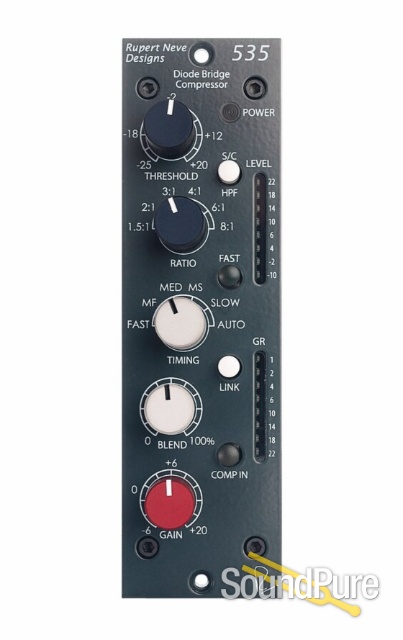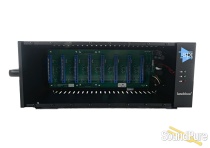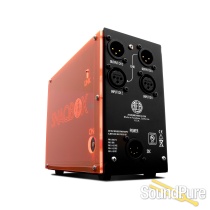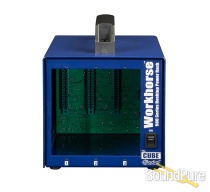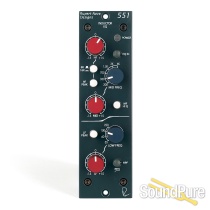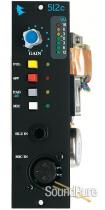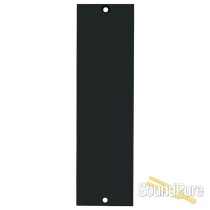-
Call Us Toll Free888-528-9703
-
Local/International (+1)919-682-5552
- Call Us! Toll Free! 888-528-9703
- Local / International (+1) 919-682-5552

Rupert Neve Designs R10 Color XL Bundle - 500 Series Rack From Neve
R10 loaded with two 542s and two 535s
Manufacturer's Description from Neve
Power You Can Trust
Power-wise, the R10 has more than 150% the required current for a 10-space chassis to prevent the power rails from failing under a higher-than-expected load. To help monitor and troubleshoot problematic modules, the R10 is equipped with LED current metering to show how much power is being used. The internal power supply itself has been carefully designed and double-shielded to avoid significant magnetic induction in any of the channel positions. With such attention to providing and monitoring power, the R10 helps your modules realize their fullest potential.
Solid Steel Construction
The chassis is comprised of solid steel with sliding nuts to accommodate various manufacturers modules. All connectors and fittings are of the highest quality to ensure that the R10 will hold up to many years of use.
A New Level of Confidence in the 500 Series
Because the R10 is built to 500 series specifications, it will work flawlessly with any properly-designed 500 series module you wish to include in it. To help accommodate modules that are slightly out of spec, the R10 has variable-position screw holes to help make the installation process as smooth as possible. The 500 series VCA buss link function can be enabled in pairs on the R6 using the link jumpers on Channels 1-2, 3-4, 5-6, 7-8 or 9-10. Enabling link allows compatible compressor modules like the 543 to share VCA control when their links are enabled. Matching blank panels are also available to cover any empty slots.
If you want to get the very best performance out of your 500 series modules, the Rupert Neve Designs R10 is the serious rack for the serious sound you want.
542 Features:
TAPE IN - Sends the signal through the “True Tape” circuitry, which is affected by the saturation, blend and 15 / 30 IPS controls.
TRIM - Provides +/– 12dB adjustment of level on incoming signal levels, prior to the tape circuit.
SATURATION - Controls the signal level being sent to the "tape head" circuit. As the saturation level increases, the level on the “record” head rises, and the replay gain is reduced so that the overall output signal level remains more or less constant. In a real tape recorder, you would adjust the record and replay gain controls separately - however, in the 542 the record and replay gain controls are coupled so that the overall signal level only varies as the “Tape” saturation level changes. As you approach maximum saturation setting, the output signal level will drop due to the effect of extreme saturation and soft clip.
Additionally, to compensate for low frequency loss at low “record head” levels, the saturation knob also controls a low frequency compensation circuit that boosts low frequencies more at low saturation levels, and tapers off at higher levels. This function can be useful on many sources like bass and kick drum to find the balance between a clean, boosted low end (low saturation) and a denser, more saturated low end (high-saturation).
15/30 IPS - Selects the pre-emphasis / de-emphasis, record / replay tape characteristic. The 15IPS mode has a significant “head bump” in the low frequencies centered around 60Hz, as well as a more pronounced roll of in the high frequencies. The 30 IPS mode is generally a flatter response through the high-end with a “head bump” around 120Hz. See the frequency plots on pages 10 & 11.
BLEND - Controls the mix of pre and post tape signals. This allows the engineer to dial in a subtle amount of the tape effect, to better control the amount of saturation, tone and soft clipping in the post blend signal. As the signal gets more saturated, dialing back the blend can be a great way to impart the feel of tape, while maintaining a similar level of detail and transparency. NOTE: The blend control does not affect the Silk and Texture controls, as that circuitry is located at the physical output of the unit.
SOFT CLIP - A soft clip engages in the “True Tape” circuitry when the drive meter hits 5 (first yellow LED), and becomes more apparent at higher levels. The soft clip can be used as a way to tame overly transient material like drums, and can be controlled further by using the blend control.
SILK / TEXTURE - Pushing the Silk button engages the Silk Red circuit, and pushing it a second time introduces Silk Blue circuitry. Silk reduces the negative feedback on the output transformer, adding harmonic content as the texture is increased. Silk Blue mode features more saturation in the lows and low mids, whereas Silk Red accentuates the saturation in the high mids and highs.
LEVEL / DRIVE METERS - Two eight segment LED bar-graph meters are fitted to the 542 for output level and drive metering. The level meter shows the output level of the 542 before the Silk circuit, and the drive meter reflects the level on the “record head” when the tape effect is engaged. The soft clip circuit is present at Drive levels above 5.
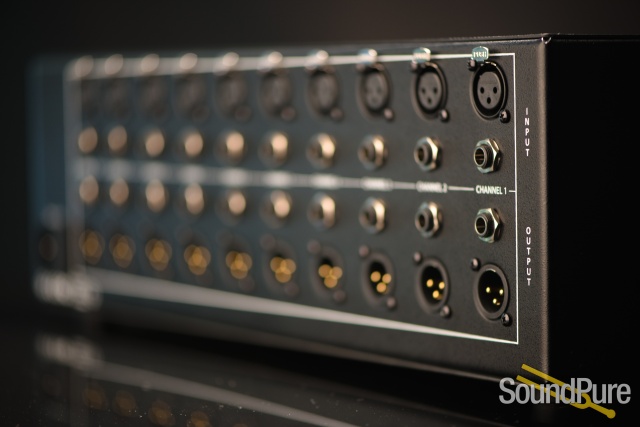
About Manufacturer
Specifications
R10
DC Voltage to Units
+/-16VDC and +48VDC for phantom power
Max Current
1000mA for modules, 150mA for 48V phantom power
Power Requirements
100-240VAC, 50/60Hz, 50 Watts
Weight
9.5lbs
Dimensions
13” long x 7.5”wide x 5.5” high
542
Line Amp Specifications (Measurements with tape circuit disengaged)
Noise
Measured at Main Output, un-weighted, 20Hz-22kHz, Input Terminated 40 Ohms.
Unity Gain Better than -100dBu
Frequency Response
Measured at +10dBu, trim at unity.
Main Output
+/- 0.25dB from 5Hz to 60Khz -2dB @ 120KHz
Maximum Output Level
23.25dBu
Total Harmonic Distortion and Noise:
@ 1kHz, +20dBu output level Better than 0.0025% @ 20Hz, +20dBu output level 0.07% Typical (2nd and 3rd harmonic)
Tape FX Specifications
Noise
Measured at gain Output, un-weighted, 20Hz-22kHz, Input Terminated 40 Ohms.
Saturation @ minimum Better than -100dBu Saturation @ maximum Better than -100dBu
Frequency Response
15 IPS, Input @ -0 dBu -3dBu @ 28kHz Saturation @ minimum 0dBu @ 10Hz +5dBu Peak @ 60Hz
Saturation @ maximum -3dBu @ 20kHz -3dBu @ 12.5Hz +2.4dBu Peak @ 60Hz
30 IPS, Input @ -0 dBu -3dBu @ 120kHz Saturation @ minimum -3dBu @ 10Hz +3.15dBu Peak @ 125Hz
Saturation @ maximum -3dBu @ 100kHz -3dBu @ 12.5Hz
+1.3dBu Peak @ 110Hz
Total Harmonic Distortion and Noise
Refer to sweeps on page10-15 IPS, Input @ -0 dBu 0.4% @ 3kHz to 1% @ 175Hz typical
Saturation @ minimum Greater than 1% below 175Hz typical
Saturation @ maximum 1% at 6kHz typical 0.3% @ 1kHz to 3% @ 50Hz typical
30 IPS, Input @ -0 dBu 1% at 1kHz typical
Saturation @ minimum 0.6% @ 400Hz 5% @ 20Hz typical
Saturation @ maximum 1.5% @ 20kHz to 0.4% @ 1kHz typical 0.4% @ 1kHz to 2 %@ 50Hz typical
Power requirements
Supplied by 500 series rack with 110-125 mA @ +/- 16V DC
535
Threshold
A 31-position detented pot that sets the level at which compression begins, from -25dB to +20dB. Turning this control counter-clockwise will increase the amount of compression; turning it clockwise will decrease the amount of compression.
Ratio
The RATIO control has six selectable positions on a rotary switch, allowing the user to set the slope of the compressor curve with pre-selected ratios of 1.5:1 through 8:1 for levels above the determined THRESHOLD. This range of compression ratios allows the user to compress as moderately or heavily as desired.
Timing
The TIMING control is a six-position rotary switch that sets the compressor attack and release times. The timing can be further modified by the FAST button.
- FAST - Fast Attack (750us), Fast Release (130ms)
- MF - Medium Attack (2.25ms), Fast Release (130ms)
- MED - Medium Attack (2.25ms), Medium Release (400ms)
- MS - Medium Attack (4ms), Slow Release (725ms)
- SLOW - Slow Attack (10ms), Slow Release (1S)
- AUTO - Medium Attack (5ms), Dual Decay Release (T1 500ms, T2 1s)
Fast
The FAST switch divides the attack and release times available on the TIMING control in half, effectively doubling the number of TIMING presets available to the user.
Blend
The BLEND control has 31 detents and allows the user to mix the uncompressed (dry) signal with compressed (wet) signal. Turning the control towards 0% will shift the mix to fully uncompressed dry signal, whereas turning the control towards 100% will shift the mix to the fully compressed signal. This feature allows for parallel compression, enabling a wider range of compression subtlety.
Gain
The GAIN control has 31 detents and allows the user to add make-up gain to the compressed signal in order to bring its level back up to unity with the uncompressed input signal. It is much easier to evaluate the tonal effect of the compressor (via the COMP IN switch) when the compressed output level is matched to the uncompressed input level, thereby eliminating potentially misleading level differences.
Comp In
The COMP IN switch allows the user to audition the compression. By disengaging the COMP IN switch, the compressor is bypassed and the user can quickly compare the compressed sound to the dry input signal for an objective evaluation of the compressor’s sonic effect on the audio signal. COMP IN can be used in combination with the GAIN control to match the perceived level of the compressed audio signal with the level of the uncompressed input signal.
Link
The LINK switch allows the compressor to be linked to another 535 compressor module via a sidechain control voltage. In link mode, the compressor generating the greater sidechain voltage (resulting in higher amounts of compression) will control the compression of both audio signal paths to maintain proper stereo center image while compressing. Note: it is advisable to always audition the unlinked sound as well, to decide if the benefit of a constant stereo center image is worth the potential trade-off of reduced left / right independence in the stereo field.
Sidechain HPF
The S/C HPF switch allows the user to insert a 12dB/octave 150Hz high-pass filter in the compressor sidechain. When this filter is engaged, the compressor will be considerably less responsive to information below 150Hz. For example: if used on a drum kit, the low end of the kick drum would have less proportional effect on the compression than a snare drum or cymbals, since a significant portion of the kick drum’s dynamic energy is focused below 150Hz.
Level and Gain Reduction Metering
These two LED meters provide accurate representations of both the output level of the compressor and the amount of gain reduction being applied to the input signal.
